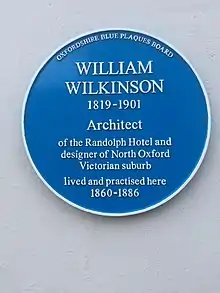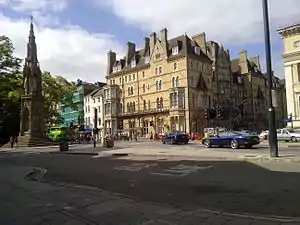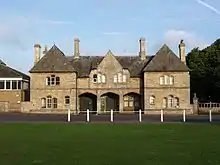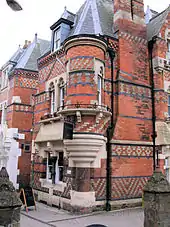William Wilkinson (architect)
William Wilkinson (1819–1901) was a British Gothic Revival architect who practised in Oxford, England.
William Wilkinson | |
|---|---|
 | |
| Born | 1819[1] |
| Died | 1901[1] |
| Nationality | British |
| Occupation | Architect |
| Practice | Wilkinson and Moore (from 1881) |
| Buildings | Randolph Hotel, Oxford; Shelswell Park, Shelswell, Oxfordshire |
| Projects | St Edward's School, Oxford; Norham Manor Estate, Oxford |
Family

Wilkinson's father was a builder in Witney in Oxfordshire.[2] William's elder brother George Wilkinson (1814–1890) was also an architect, as were William's nephews C.C. Rolfe (died 1907) and H.W. Moore (1850–1915).[1]
Career
Most of Wilkinson's buildings are in Oxfordshire. His major works include the Randolph Hotel in Oxford, completed in 1864. He was in partnership with his nephew H.W. Moore[1] from 1881.[3] In his long career Wilkinson had a number of pupils, including H.J. Tollit (1835–1904).[4]
Works
Churches
In 1841, at the age of only 22, Wilkinson designed a new Church of England parish church, Holy Trinity at Lew, Oxfordshire.[5] His other work on churches included:
- St Leonard's parish church, Eynsham: restoration, 1856[6]
- Witney Cemetery: lodge and two chapels, 1857[7]
- Witney Workhouse: chapel, 1860[8]
- All Saints' parish church, Middleton Cheney, Northamptonshire: Horton family mausoleum, 1866–67[9]
- St Andrew's parish church, Headington, Oxford: added north aisle, 1880[10]
Police buildings

Wilkinson moved to Oxford in 1856 and succeeded J.C. Buckler as architect to the local police committee.[2] Oxfordshire County Constabulary was formed in 1857, and Wilkinson designed several buildings for the new force.
- Watlington police station, 1858–59[11]
- Witney police station, 1860[7]
- Woodstock police station, 1863[12]
- Chipping Norton police station, 1864–65[13]
- Burford police station, 1869[14]
- Magistrates' room at Deddington Court House, 1874[15]
Houses
Wilkinson designed Home Farm on the Shirburn Castle estate, built in 1856–57.[16] From 1860 he laid out the Norham Manor estate in north Oxford.[17][18] The estate was slowly developed with large villas, a number of which Wilkinson designed himself.[19] Wilkinson also designed town houses and small country houses elsewhere in Oxfordshire:

- Hollybank, Wootton, 1862–63[20]
- 10, Broad Street, Oxford, 1863[21]
- Whittlebury, Northamptonshire: farmhouse, 1864[22]
- The Holt, Middleton Cheney, Northamptonshire, 1864[9]
- 60 Banbury Road, Oxford, 1865–66[23]
- Bignell House, Chesterton, 1866 (partly demolished)[24]
- 23 and 24 Cornhill, Banbury, 1866[25]
- Astrop Park, Northamptonshire: lodge, pheasantry and cottage, 1868[26]
- Witney Almshouses: restoration, 1868.[27]
- Brashfield House, Caversfield, 1871–73[28]
- Shelswell Park, Shelswell, 1875[29]
- Cowley Place (now St Hilda's College, Oxford): extension, 1877–78[30][31]
Clergy houses
A number of the houses that Wilkinson designed were for clergy. Most were for the Church of England, but he also designed a presbytery that was built for the Roman Catholic Church.
- Ramsden parsonage, 1862[32]
- Chadlington parsonage, 1863 (now Chadlington House)[33]
- Duns Tew rectory, 1864 (now Priory Court)[34]
- Godington parsonage, 1867 (now the Old Vicarage)[35]
- Upper Heyford parsonage, 1869[36]
- Rousham rectory: enlargement and remodelling, 1873.[37]
- St Aloysius' presbytery, Woodstock Road, Oxford, 1877–78[38]
- Combe vicarage and Institute (with H.W. Moore), 1892–93[39]
Educational establishments
Wilkinson designed the library for the Oxford Union, built in 1863.[40] He designed a number of schools, of which the largest was St Edward's School, Oxford, whose buildings he completed in phases from 1873 until 1886.[41][42] His other schools include:
Industrial buildings
Late in his career Wilkinson undertook one industrial commission: a new smith shop and foundry for William Lucy's Eagle Ironworks in Jericho, Oxford. This single-storey building was completed in 1879.[48] It was demolished after Lucy ceased production in England in 2005.[49]
Publications
- Wilkinson, William (1875) [1870]. English Country Houses: Sixty-one Views and Plans of Recently Erected Mansions, Private Residences, Parsonage-Houses, Farm-Houses, Lodges, and Cottages; with Sketches of Furniture and Fittings; and a Practical Treatise on House-Building (second ed.). London: James Parker and Co.
See also
References
- Brodie et al. 2001, p. 994.
- Tyack 1998, p. 234.
- Tyack 1998, p. 267.
- Woolley 2010, p. 71.
- Sherwood & Pevsner 1974, pp. 682–683.
- Sherwood & Pevsner 1974, p. 600.
- Sherwood & Pevsner 1974, p. 846.
- Sherwood & Pevsner 1974, p. 851.
- Pevsner & Cherry 1973, p. 306.
- Sherwood & Pevsner 1974, p. 336.
- Sherwood & Pevsner 1974, p. 830.
- Sherwood & Pevsner 1974, p. 857.
- Sherwood & Pevsner 1974, p. 539.
- Sherwood & Pevsner 1974, p. 509.
- Sherwood & Pevsner 1974, p. 572.
- Sherwood & Pevsner 1974, p. 763.
- Tyack 1998, pp. 234–235.
- Sherwood & Pevsner 1974, p. 317.
- Sherwood & Pevsner 1974, p. 318.
- Sherwood & Pevsner 1974, p. 860.
- Sherwood & Pevsner 1974, p. 313.
- Pevsner & Cherry 1973, p. 461.
- Sherwood & Pevsner 1974, p. 319.
- Sherwood & Pevsner 1974, p. 618.
- Sherwood & Pevsner 1974, p. 440.
- Pevsner & Cherry 1973, p. 529.
- Sherwood & Pevsner 1974, p. 847.
- Sherwood & Pevsner 1974, p. 524.
- Sherwood & Pevsner 1974, p. 753.
- Tyack 1998, p. 323.
- Sherwood & Pevsner 1974, p. 245.
- Sherwood & Pevsner 1974, p. 734.
- Sherwood & Pevsner 1974, p. 525.
- Sherwood & Pevsner 1974, p. 591.
- Sherwood & Pevsner 1974, p. 613.
- Sherwood & Pevsner 1974, p. 821.
- Crossley 1983, pp. 159–168.
- Sherwood & Pevsner 1974, pp. 289, 332.
- Sherwood & Pevsner 1974, p. 553.
- Sherwood & Pevsner 1974, p. 273.
- Tyack 1998, p. 238.
- Sherwood & Pevsner 1974, p. 332.
- Townley 2004, pp. 254–255.
- Sherwood & Pevsner 1974, p. 710.
- Sherwood & Pevsner 1974, p. 510.
- Sherwood & Pevsner 1974, p. 809.
- Sherwood & Pevsner 1974, p. 343.
- Woolley 2010, pp. 85, 86.
- Woolley 2010, p. 87.
Sources
- Brodie, Antonia; Felstead, Alison; Franklin, Jonathan; Pinfield, Leslie; Oldfield, Jane, eds. (2001). Directory of British Architects 1834–1914, L–Z. London & New York: Continuum. p. 994. ISBN 0-8264-5514-X.
- Crossley, Alan (ed.); Baggs, A.P.; Colvin, Christina; Colvin, H.M.; Cooper, Janet; Day, C.J.; Selwyn, Nesta; Tomkinson, A. (1983). A History of the County of Oxford. Victoria County History. 11: Wootton Hundred (northern part). London: Oxford University Press for the Institute of Historical Research. pp. 159–168. ISBN 978-0-19722-758-9.CS1 maint: extra text: authors list (link)
- Pevsner, Nikolaus; Cherry, Bridget (revision) (1973) [1961]. Northamptonshire. The Buildings of England (2nd ed.). Harmondsworth: Penguin Books. ISBN 0-14-071022-1.
- Saint, Andrew (1970). "Three Oxford Architects". Oxoniensia. Oxfordshire Architectural and Historical Society. XXXV: 53 ff. Retrieved 3 November 2009.
- Sherwood, Jennifer; Pevsner, Nikolaus (1974). Oxfordshire. The Buildings of England. Harmondsworth: Penguin Books. ISBN 0-14-071045-0.
- Townley, Simon C. (ed.); Baggs, A.P.; Chance, Eleanor; Colvin, Christina; Cooper, Janet; Day, C.J.; Selwyn, Nesta; Williamson, Elizabeth; Yates, Margaret (2004). A History of the County of Oxford. Victoria County History. 14: Witney and its Townships: Bampton Hundred (Part Two). Woodbridge: Boydell & Brewer for the Institute of Historical Research. pp. 254–255. ISBN 978-1-90435-625-7.CS1 maint: extra text: authors list (link)
- Tyack, Geoffrey (1998). Oxford An Architectural Guide. Oxford & New York: Oxford University Press. ISBN 0-19-817423-3.
- Woolley, Liz (2010). "Industrial Architecture in Oxford, 1870 to 1914". Oxoniensia. Oxfordshire Architectural and Historical Society. LXXV: 67–96. ISSN 0308-5562.